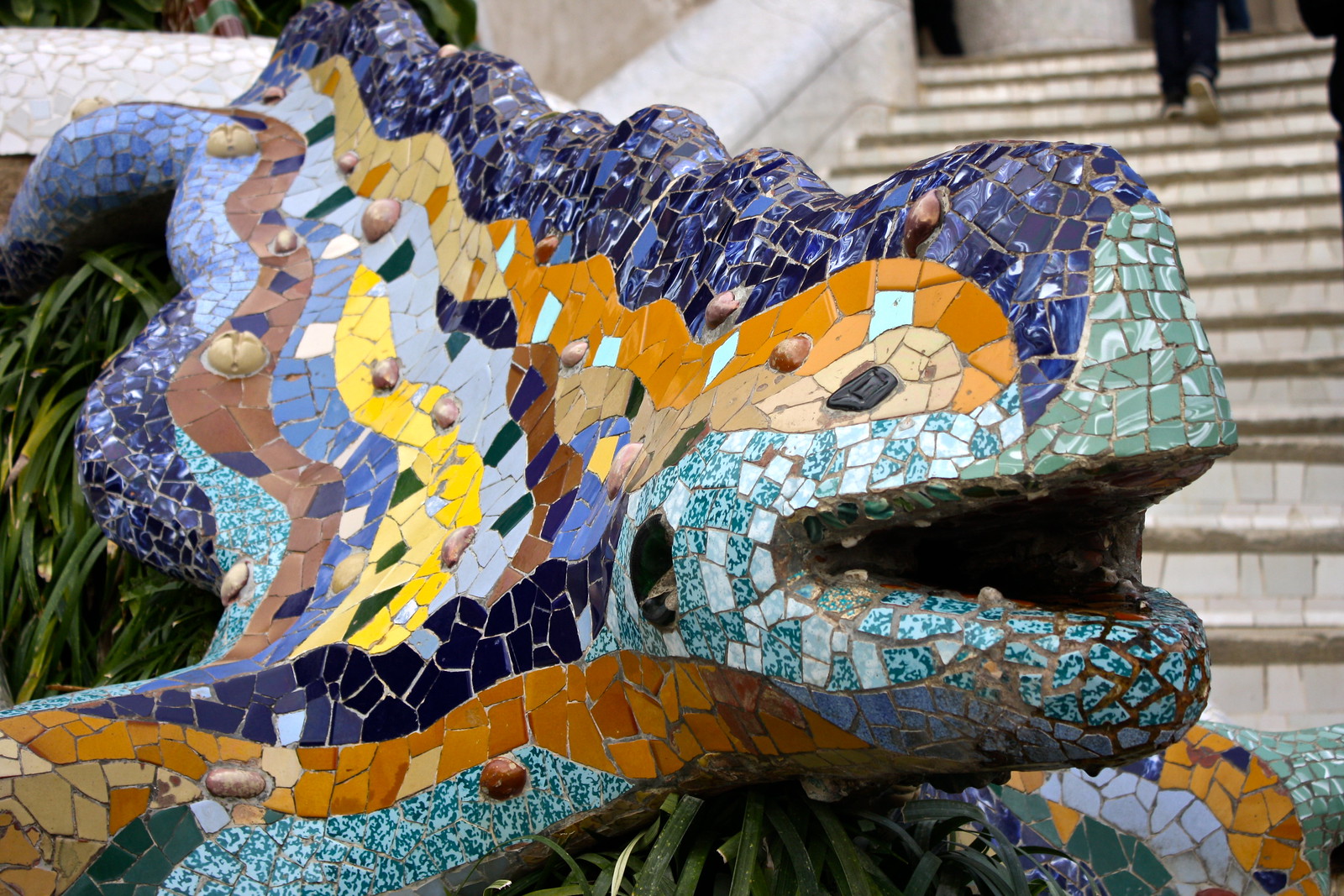Gaudí Week #3: Park Güell in Barcelona, Spain
This week on the blog, I’m celebrating works by the famous turn-of-the-century Catalan architect Antoni Gaudí, who designed everything from churches to mansions to public parks. This post is the third in a seven-part series; check out the introduction here!
Park Güell is one of the most famous tourist destinations in Barcelona. First, a little background on who this Güell guy was (pronounced “GWAY-ee” [gweʎ]), since he shows up in two more buildings I’m talking about later in the week. Eusebi Güell made a fortune in the textile business as the Spanish region of Catalunya rapidly industrialized in the late 19th century. Early on in Gaudí’s life, the two met and Güell became one of the architect’s biggest patrons. Between 1900 and 1914, work was done on an idealized subdivision for the wealthy on land purchased by Güell, but because few of the upper class at the time cared for Gaudí’s style and/or Modernisme, the project was halted. Still, both Güell and Gaudí ended up living in two of the handful of houses built in the park, none built by Gaudí himself, though.
(There seems to be a lot of confusion about how to spell this neighborhood-turned-city park. Güell was inspired by England’s Garden City movement, or utopian urban planning that emphasized parks and green space, and so spelled it Park Güell instead of the Catalan parc or the Spanish parque.)
Across the park, he decorated buildings and structures with a technique he popularized called trencadís. Taking shards and pieces of broken ceramic tiles, plates, etc., he arranged them in such a way to create flowing mosaics and shapes, covering walls, ceilings, benches, and statues with these imperfect tiles. The most beloved piece he created is el drac, “the dragon” or lizard that’s crawling down toward the entrance to Park Güell, covered in fun blue, orange, and green tiles.
Main sights include: the two unassuming pavilions at the southern entrance; the Sala Hipóstila—it looks like a wavy Greek temple with a forest of columns and has the world’s longest bench on its roof; vaulted, colonnaded paths made from local stone that swoop into hillsides; and a megalithic mini Calvary with three crosses on its summit which offers a commanding view of the whole city. There’s a lot to be said for simply strolling around the grounds and enjoying the mix of deciduous and palm trees, a welcome break from the city air. As you wander, try to imagine what the currently-empty estate was supposed to look like: luxury homes set on roomy lots, all surrounded by lush, shady vegetation.
If you’ve been to Barcelona, did you visit the touristy Park Güell or did the crowds scare you away? Comment below!
 |
| Entrance to Park Güell |
Park Güell is one of the most famous tourist destinations in Barcelona. First, a little background on who this Güell guy was (pronounced “GWAY-ee” [gweʎ]), since he shows up in two more buildings I’m talking about later in the week. Eusebi Güell made a fortune in the textile business as the Spanish region of Catalunya rapidly industrialized in the late 19th century. Early on in Gaudí’s life, the two met and Güell became one of the architect’s biggest patrons. Between 1900 and 1914, work was done on an idealized subdivision for the wealthy on land purchased by Güell, but because few of the upper class at the time cared for Gaudí’s style and/or Modernisme, the project was halted. Still, both Güell and Gaudí ended up living in two of the handful of houses built in the park, none built by Gaudí himself, though.
(There seems to be a lot of confusion about how to spell this neighborhood-turned-city park. Güell was inspired by England’s Garden City movement, or utopian urban planning that emphasized parks and green space, and so spelled it Park Güell instead of the Catalan parc or the Spanish parque.)
Across the park, he decorated buildings and structures with a technique he popularized called trencadís. Taking shards and pieces of broken ceramic tiles, plates, etc., he arranged them in such a way to create flowing mosaics and shapes, covering walls, ceilings, benches, and statues with these imperfect tiles. The most beloved piece he created is el drac, “the dragon” or lizard that’s crawling down toward the entrance to Park Güell, covered in fun blue, orange, and green tiles.
 |
| Trencadís tile mosaics at Park Güell |
Main sights include: the two unassuming pavilions at the southern entrance; the Sala Hipóstila—it looks like a wavy Greek temple with a forest of columns and has the world’s longest bench on its roof; vaulted, colonnaded paths made from local stone that swoop into hillsides; and a megalithic mini Calvary with three crosses on its summit which offers a commanding view of the whole city. There’s a lot to be said for simply strolling around the grounds and enjoying the mix of deciduous and palm trees, a welcome break from the city air. As you wander, try to imagine what the currently-empty estate was supposed to look like: luxury homes set on roomy lots, all surrounded by lush, shady vegetation.
 |
| The lizard, Park Güell |
How to get there
Park Güell is located up a hill to the northeast of the Gràcia district. Take the L3 (green line) on the Metro and get off at either the Lesseps or Vallcarca stops. If you get off at Lesseps, head east on Travessera de Dalt for a few minutes until you see escalators that will carry you north up the hill and leave you near the main southern entrance. If you get off at Vallcarca, head due east until you run into escalators that will take you east up the hill and drop you off at the western gate.If you’ve been to Barcelona, did you visit the touristy Park Güell or did the crowds scare you away? Comment below!